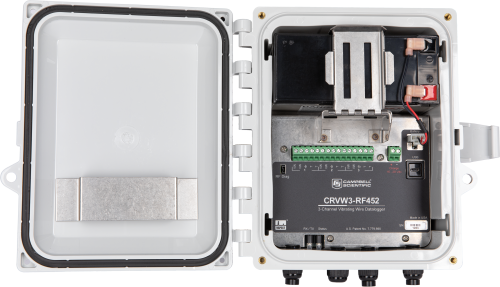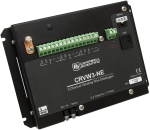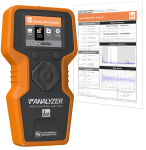
特許技術VSPECT®を使用






概要
ダイナミックバイブレーティングワイヤ測定技術は、米国特許番号 8,671,758 で保護されており、バイブレーティングワイヤスペクトル分析テクノロジ (VSPECT®) は、米国特許番号 7,779,690 で保護されています。
続きを読む利点と特徴
- 1 ~ 3 個のバイブレーティングワイヤセンサからデータを読み取って保存
- ソーラーパネル接続用充電レギュレータ内蔵
- IP66 定格の屋外収納ケース
- シンプルなプログラミングインターフェイス
- 統合型の充電式またはアルカリ電池オプション
- 既存の多くの Campbell Scientific データ取得ネットワークとの互換性
- PakBus ルーター/無線リピーター機能
イメージ







詳細
注意: CRVW3 には、 Device Configuration Utility (DevConfig) v 2.10以降が必要です。無線オプションを使用する場合、CRVW3 には LoggerNet v 4.3以降が必要です。
仕様
| -注意- |
|
| 動作温度範囲 |
|
| プロセッサ | ST ARM CORTEX-M4 (32 ビット、ハードウェア FPU、144 MHz で動作) |
| データストレージ | 16 MB シリアル フラッシュ、最大 420,000 レコード (シングル チャネル)、最大 160,000 レコード (3 チャネル) |
| リアルタイム クロックの精度 | ±3 分/年 |
| 測定間隔範囲 | 1 秒 ~ 1 日 |
| USB Micro B | PC に直接接続 (設定とデータ収集用に電源を供給)、2.0 フル スピード、12 Mbps |
| 構成 | ソフトウェア構成可能、プログラミング不要 |
| コンプライアンス | RoHS |
| 保証 | 材料および製造上の欠陥に対する 1 年間の保証 |
| 屋外収納ケースの定格 | NEMA 4X (IP66)ケーブル挿入口を適切に使用した場合 |
| エンクロージャの取り付け | ポール/壁取り付け用のステンレススチール製ユニバーサルマウント (オプション) またはプラスチック製取り付けタブ (付属) |
| 静的バイブレーティングワイヤ測定 | 対応 |
| 筐体寸法 | 24.1 x 22.9 x 14.0 cm (9.5 x 9.0 x 5.5 インチ) |
| 重量 |
|
電源 |
|
| 充電端子 | 16 ~ 28 Vdc (ソーラーパネルまたは DC 電源コンバータから) |
| バッテリオプション | 充電式 7 Ah または 8 本の 単一アルカリ電池 |
| 消費電流 |
|
計測 |
|
| チャンネル数 | 3 つのバイブレーティングワイヤ (VW) と 3 つのサーミスタ/RTD (温度) 測定 |
| 測定速度 | センサあたり 1 秒 (VWと温度) |
計測 - バイブレーティングワイヤ |
|
| 測定励起オプション | 2 V (±1 V)、5 V (±2.5 V)、12 V (±6 V) |
| 測定 (周波数) 分解能 | 0.001 Hz RMS (-40° ~ +70°C) |
| 時系列基本分解能 | 24 ビット ADC |
| 測定正確度 | 読み取り値の ±0.005% (-40°~+70°C) |
| 測定方法 | VSPECT® (スペクトル解析)、米国特許番号 7,779,690、診断データを含む |
計測 - 温度(抵抗) |
|
| -注意- | サーミスタまたは RTD 抵抗は、メーカーの仕様に従って温度 (℃) にスケーリングできます。結果として得られる温度は、センサの出力の補正係数として使用できます。 |
| 測定方法 | ハーフブリッジ レシオメトリック、24 ビット ADC、組み込み完了抵抗 4.99 kΩ 0.1% |
| サーミスタ精度 | 0.020 Ω RMS @ 3000 Ω (ほとんどのバイブレーティングワイヤサーミスタの場合、約 0.00015 °C RMS) |
| 正確度 | 読み取り値の ±0.15% (-40° ~ +70°C) |
-RF407 オプション |
|
| 内部無線の説明 | 5 ~ 250 mW、ユーザー選択可能、902 ~ 928 MHz ライセンスフリー バンド、周波数ホッピング スペクトラム拡散無線 |
| 無線リピーター | -RF407 オプションを備えたデバイスは、無線リピーターとして設定できます。 |
| 使用場所 | 米国、カナダ |
| コンプライアンス情報 |
|
-RF412 オプション |
|
| 内部無線の説明 | 5 ~ 250 mW、ユーザー選択可能、915 ~ 928 MHz ライセンスフリー バンド、周波数ホッピング スペクトラム拡散無線 |
| 無線リピーター | -RF412 オプションを備えたデバイスは、無線リピーターとして設定できます。 |
| 使用場所 | オーストラリア |
| コンプライアンス情報 |
|
-RF422 オプション |
|
| 内部無線の説明 | 2 ~ 25 mW、ユーザー選択可能、863 ~ 870 MHz ライセンスフリー バンド、周波数ホッピング スペクトラム拡散無線 |
| 使用場所 | ヨーロッパおよびアジアの一部 (ETSI) |
| EU 適合 | 「Web ページのドキュメント セクションで EU 適合宣言書をご覧ください。」 |
-RF452 オプション |
|
| 内部無線の説明 | 10 ~ 1,000 mW、ユーザー選択可能、902 ~ 928 MHz ライセンスフリー バンド、周波数ホッピング スペクトラム拡散無線 |
| 無線リピーター | -RF452 オプションを備えたデバイスは、無線リピーターとして設定できます。 |
| 使用場所 | 米国、カナダ、オーストラリア |
| コンプライアンス情報 |
|
互換性
センサ
ネットワークに関する考慮事項
| RF400a | RF401A RF401a RF430a |
RF407 | RF411A RF410a RF411a RF431a |
RF412 | RF416 RF432a RF415a |
RF422 | RF450a RF451a RF452 |
|
| CRVW3-RF407 |  |
|||||||
| CRVW3-RF412 |  |
|||||||
| CRVW3-RF422 |  |
|||||||
| CRVW3-RF451 |  |
|||||||
| CRVW3-RF452 |  |
注意: a製造終了製品です。現在入手できません。
屋外収納ケースに関する考慮事項
電源に関する考慮事項
CRVW3 は、充電式バッテリまたは 単一アルカリ電池パックのいずれかと一緒に注文できます。充電式バッテリを使用する場合、CRVW3 はソーラー パネルに簡単に配線でき、充電式バッテリは CRVW3 の内蔵レギュレータを使用して充電されます。
ドキュメント
コンプライアンス
- CRVW3 EU Declaration of Conformity
- CRVW3 UK Declaration of Conformity
- CRVW3-RF407 FCC Supplier Declaration of Conformity and FCC Statement
- CRVW3-RF422 and CRVW3-NE-RF422 EU Declaration of Conformity
- CRVW3-RF422 and CRVW3-NE-RF422 UK Declaration of Conformity
- RF427 Brazilian Certificate of Conformity
ダウンロード
Device Configuration Utility v.2.32.01 (47.7 MB) 15-04-2025
A software utility used to download operating systems and set up Campbell Scientific hardware. Also will update PakBus Graph and the Network Planner if they have been installed previously by another Campbell Scientific software package.
Supported Operating Systems:
Windows 11 or 10 (Both 32 and 64 bit)
CRVWx Firmware v.4.04 (931 KB) 09-05-2023
Current version of the CRVWx firmware. Requires the Device Configuration Utility to upload the firmware to the CRVWx.
よくある質問
CRVW3に関するよくある質問の数: 11
すべて展開すべて折りたたむ
-
CRVW3 は、バイブレーティング ワイヤ センサとサーミスタの測定に約 1 秒かかります。3 つのチャンネルすべてがセンサを測定している場合、CRVW3 は、サイクルを再開する準備ができるまで、センサの測定に約 3 秒かかります。
-
はい。電池は、D セル電池オプションと充電式電池オプションの間でいつでも切り替えることができます。
-
通信オプション (–RF451 など) は、製造プロセス中に CRVW3 がどのように構築されるかを反映します。特定の通信オプションを指定して CRVW3 を注文すると、そのオプションが保持されます。ワイヤレス通信をオフにして、CRVW3 をスタンドアロンのデータロガーとして展開することもできます。
-
はい。CRVW3 はスタンドアロンのデータロガーとして使用できます。CRVW3 がネットワークに接続されていない場合は、マニュアルに記載されているように、CRVW3 に直接接続するか (USB 経由)、簡単なワイヤレス接続を介してデータを収集します。
-
いいえ。CRVW3 にはメモリが内蔵されており、さまざまな方法で設定できます。データを頻繁に測定し、低速でデータを通信できます (たとえば、10 分ごとに測定し、結果を 1 日に 1 回通信する)。CRVW3 は、測定が行われた後にデータを通信することもできます。ネットワーク上の通信をアプリケーションの特定のニーズに合わせて設定できるため、ユーザーは CRVW3 だけでなくベース データロガーの電力消費をより適切に管理できます。
-
いいえ。CRVW3 は、最小限の変更で簡単に導入できるシステムとして設計されています。CRVW3 は設計がシンプルなため、マルチプレクサは使用できません。アプリケーションでマルチプレクサが必要な場合は、代わりに CR6 計測・制御データロガーの使用を検討してください。
-
それほど多くはありません。CRVW3 は、現場で構成、インストール、配線する必要があります。これらの手順は、CRVW3 に同梱されているクイック デプロイ ガイドに記載されており、この Web サイトからダウンロードすることもできます。マニュアルは、インストールに関する質問に対応するより詳細なリソースです。
-
はい。CRVW3 は、他の PakBus データロガーと通信できる PakBus デバイスです。ネイバー データ ロガーには、CRVW3 無線オプションと互換性のある無線デバイスが必要です。CRVW3-RF451 モデルを使用する場合、ワイヤレス通信を有効にするには、ネイバー デバイスに RF450 または RF451 無線がインストールされている必要があります。最初のネイバーに接続した後、PakBus ルーティングを使用して、任意のタイプのアクティブな通信リンク (TCP/IP、WiFi など) を介して、そのネイバーが利用できる他の PakBus デバイスに到達できます。Network Plannerは、ネットワークを設計し、デバイスがどのように通信するかを調べるために使用される LoggerNet 内のツールです。
-
CRVW3 の注文方法に応じて、複数の通信オプションがあります。すべての CRVW3 デバイスは、内蔵の USB 接続を使用してデータを通信し、設定することができます。CRVW3 をワイヤレス通信オプション付きで注文すると、PC または別のデータロガーにワイヤレスでデータを通信することもできます。
-
はい。既存のネットワークに接続するには、同じまたは互換性のある無線を使用することが重要です。ネットワークで古い無線モデルが使用されている場合は、無線を最新のモデルに更新するか、2 種類の無線を 1 つのデータロガーで使用して無線テクノロジ ブリッジ (ゲートウェイ) として機能させることができます。たとえば、RF401 と RF450 を搭載した CR1000 は、古い RF401 互換デバイスだけでなく、CRVW3-RF451 とも通信できます。
記事とプレスリリース
ブログ記事
-
A Closer Look: Resolving Dam Data Discrepancies

05-03-2024 著者: Eric Schmidt -
Get the Most out of VSPECT®

22-08-2023 著者: Jacqalyn Maughan -
Use VSPECT® to Verify: Bad Sensors or Bad Data?

06-04-2023 著者: Jacqalyn Maughan -
Troubleshooting Vibrating Wire Piezometers

28-03-2023 著者: Nathanael Wright -
How to Obtain Vibrating Wire Measurements in Environments with High Electromagnetic Noise

07-10-2020 著者: Timothy Jeppsen -
Why Should You Use a Vibrating Wire Data Logger?

14-02-2018 著者: Robin Deissinger
Privacy Policy Update
We've updated our privacy policy. 詳細はこちら
Cookie Consent
Update your cookie preferences. クッキーの設定を更新する








